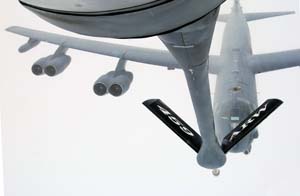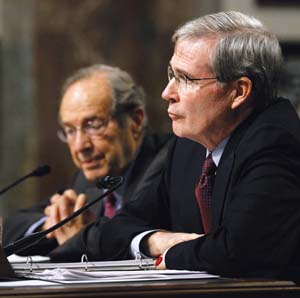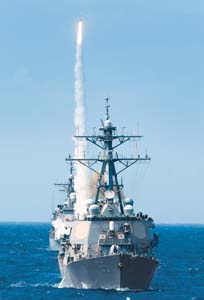Ever since President Dwight D. Eisenhower created Project Solarium in 1953, with its three competing teams of top military and diplomatic officials arguing different approaches for winning the Cold War, officials have turned to the Red Team approach in developing national strategy. The latest “Red Team” to make waves in Washington is the Quadrennial Defense Review independent panel, tasked by Congress to test the assumptions and findings of last year’s QDR.
In its recently released final report, “The QDR in Perspective: Meeting America’s National Security Needs in the 21st Century,” the independent panel of national security experts did not just review current plans for US military force structure, personnel, weapons modernization, and defense spending. The panel essentially turned conventional wisdom on its head. If Congress and the Administration choose to pay attention, the recommendations will bolster the Air Force and its future capabilities.
The independent panel found current DOD plans unsustainable and inadequate for the demands of an unpredictable world. The panel thus calls for a significantly larger fleet of Navy warships and expanded Air Force “deep strike” capability—primarily to counter the threat posed by a newly assertive China. The panel also calls for the current level of ground forces to be maintained, because they are needed to win the wars in Afghanistan and Iraq and to meet future demands for counterinsurgency and stability operations.
 |
|
The panel, co-chaired by former Defense Secretary William J. Perry and former National Security Advisor Stephen J. Hadley, also argues that an arsenal of weapons systems worn down by years of constant combat must be rapidly replaced. Additionally, unspecified National Guard units should be dedicated exclusively to the homeland defense mission, and cyber defenses substantially improved.
Most notably, the independent panel calls for a significantly larger defense budget topline to pay for it all.
“Secretary [Robert M. ] Gates’ directive on efficiencies to deal with DOD costs is a good start, but in our judgment will not be sufficient,” said Perry, testifying before the Senate Armed Services Committee.
Additional topline spending will be required, he said. “What we have described as a need [in the report] will be expensive. But deferring recapitalization” could result in even higher costs in the long run.
“An explicit warning is appropriate,” Perry and Hadley testified. “The aging of the inventories and equipment used by the services, the decline in the size of the Navy, escalating personnel entitlements, increased overhead and procurement costs, and the growing stress on the force mean that a train wreck is coming in the areas of personnel, acquisition, and force structure.”
Hadley noted that the panel’s instruction from Congress was to review the planned US military force in light of current and evolving strategic threats, “unconstrained” by concerns about costs or affordability.
“The country has to be prepared to increase the topline,” Hadley testified. “And our expectation is there may need to be some increase.”
 |
QDR independent panel co-chairs William Perry (l) and Stephen Hadley testify before Congress. ( AP photo by Alex Brandon) |
The report criticizes the 2010 QDR for dropping the venerable “force planning construct” that shaped the US military throughout the post-Cold War era: the need to be able to fight and win two conventional wars, nearly simultaneously. After 9/11, that force planning construct was amended, with the 2005 QDR calling for a force that could defeat one conventional foe while also waging a long-duration irregular warfare campaign, and protect the homeland against attack. The panel called Gates’ decision to drop a clearly articulated force planning construct in the 2010 QDR a “missed opportunity.”
Lacking such a force planning construct to evaluate, the panel actually embraced the general force structure baseline contained in the 1993 Bottom-Up Review.
“Although it may seem counterintuitive to look to a 17-year-old review for guidance for the future, the panel decided [that] … given the stress on the force over the last 15 years and the increasing missions that the Department of Defense has assumed, it is unlikely that the United States can make do with less than it needed in the early 1990s, when Americans assumed the world would be much more peaceful post-Cold War.”
The independent panel found the Air Force’s current force structure generally acceptable, but recommended a steep increase in USAF’s deep strike platforms and capabilities. Whereas the 2010 QDR calls for a long-range bomber force of 96 aircraft, for instance, the 1993 BUR baseline embraced by the panel recommended a force of 184 long-range bombers.
When asked during his Senate testimony whether that recommendation meant the Air Force should modernize its existing, old bomber fleet by more rapidly developing a next generation bomber, Perry was unequivocal.
“My answer to that is a short one, which is, ‘Yes,’ ” said Perry.
He elaborated in House testimony by saying a new bomber “should be a follow-on to the B-2 and have the kind of stealth capabilities that the B-2 has. That’s the unique capability that the United States has today, and one which will be very important … in any new deep strike bomber.”
In an Aug. 11 letter to Congress, Gates said he agrees with the panel’s conclusions that “the Air Force will need to place greater emphasis on unmanned aerial vehicles and long-range strike capabilities in the mix of capabilities it fields.”
The panel’s emphasis on maritime power projection and deep strike capabilities comes with China’s military buildup in mind. Adm. Michael G. Mullen, Chairman of the Joint Chiefs, recently said his view of China’s largely opaque military buildup had evolved from being “curious” to “concerned.”
“As a Pacific power, the US presence in Asia has underwritten the regional stability that has enabled India and China to emerge as rising economic powers. The United States should plan on continuing that role for the indefinite future,” the report notes. “The panel remains concerned that the QDR force structure may not be sufficient to assure others that the United States can meet its treaty commitments in the face of China’s increased military capabilities.”
Adopting this force structure construct would have the greatest impact on the Navy. Whereas the 2010 QDR calls for increasing the size of the Navy fleet from the current 285 ships to roughly 322, the panel recommends a fleet of 346 ships. It also calls for modernizing the fleet with a new attack submarine, a next generation cruiser, and improved countermeasures to anti-access weapons such as anti-ship missiles and submarines. In analyzing the strategic landscape, the independent panel identified four vital interests of the United States, and a handful of current or evolving threats to those interests. As the underwriter of global security, the panel argues the United States and its military forces must adequately defend the homeland; assure access to the global sea, air, space, and cyberspace commons; preserve a favorable balance of power across Eurasia; and provide for the global “common good” through such actions as disaster relief, humanitarian aid, and development assistance.
 |
USS Benfold leads USS Chosin (back), as a surface-to-air missile is fired during a RIMPAC 2010 exercise. (USN photo by Mass Comm. Spec. 2nd Class Mark Logico)
|
As major threats to the stability of that international system, the panel identified the spread of radical Islamist extremism and its attendant terrorism; the rise of new global great powers in Asia, with China and India at their fore; a continued struggle for power among myriad actors in the Greater Middle East; an accelerating global competition for resources ranging from oil to land and water; and the persistent problem of failed and failing states.
Hard Choices, Necessary Choices “These trends are likely to place an increased demand on American ‘hard power’ to preserve regional balances,” the report notes, stressing that the United States cannot realistically relinquish the burden of trying to stabilize that often fragile international order. “While diplomacy and development have important roles to play, the world’s first-order concerns will continue to be security concerns.”
However, the key problem confronted in both the independent panel report and the QDR is that the tools of American hard power are showing signs of severe stress and wear.
The post-Cold War 1990s were characterized by defense cuts and attempts to seize “peace dividends,” for instance, by reducing the size of US armed forces by roughly 40 percent. “The general trend has been to replace more with fewer more-capable systems,” the panel says in its report. “Beyond a certain point, quality cannot substitute for quantity.”
Meanwhile, the post-9/11 period has seen nearly constant combat in Afghanistan and Iraq, accompanied by a delay in equipment modernization as money shifted to warfighting accounts. This took place at the same time as a steady growth in new missions to include counterterrorism, counterproliferation, cyber security, and homeland defense.
“There is increased operational tempo for a force that is much smaller than it was during the years of the Cold War. In addition, the age of major military systems has increased within all of the services, and that age has been magnified by wear and tear through intensified use,” the report notes.
Sticking with a “business as usual” approach could have unacceptable consequences, the panel writes.
Continuing to buck conventional wisdom, the panel recommends sticking to current ground troop levels for the foreseeable future. This despite the fact that troop levels have dropped in Iraq by roughly half this year (from nearly 100,000 to 50,000 by Aug. 31), and that under the current status of forces agreement, US troops are scheduled to leave Iraq by the end of 2011.
While the Obama Administration has “surged” forces to Afghanistan over the past year, bringing troop levels there near the 100,000 mark, it has also promised to begin withdrawing them in July 2011.
“The current end strength of the active duty ground forces is close enough to being correct that adjustment to that number is not a top priority,” the panel’s report determines. “The need to deal with irregular and hybrid threats will tend to drive the size and shape of ground forces for years to come, whereas the need to continue to be fully present in Asia and the Pacific and other areas of interest will do the same for naval and air forces.”
Spiraling personnel costs are rapidly making current ground force levels unaffordable. Failing to address the increasing costs will “likely result in a reduction in the force structure, a reduction in benefits, or a compromised all-volunteer force.”
Sweeping personnel changes are needed, perhaps by lengthening military careers to 40 years; abandoning the “up or out” promotion model; emphasizing up-front cash bonuses for re-enlistment over expensive long-term benefits; and adjusting contributions to the Tricare health care system.
While acknowledging that all of those reforms are controversial, the panel warns that hard choices are now necessary to close the widening and increasingly dangerous gap between the reach of a downsized and overstressed US military force and America’s strategic goals.
“The budget pressures facing the Department of Defense in the future are certain to be severe,” the panel concludes. “If the long-term cost trends in the areas of personnel, operations and maintenance, and acquisition cannot be reversed or modified, the outcome will be stark, and the consequences for US national security will be enormous.”
James Kitfield is the defense correspondent for National Journal in Washington, D.C. His most recent article for Air Force Magazine, “Crowded, Congested Space,” appeared in the August issue.